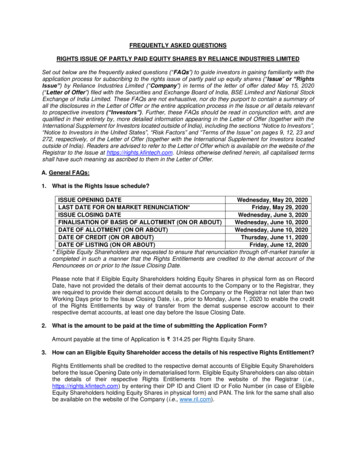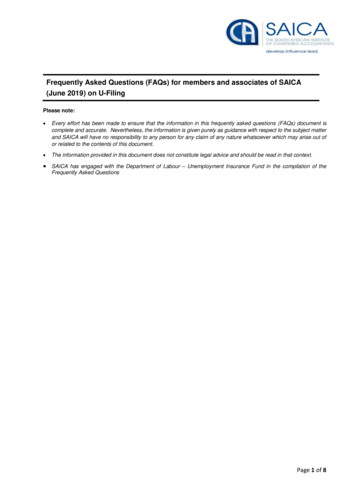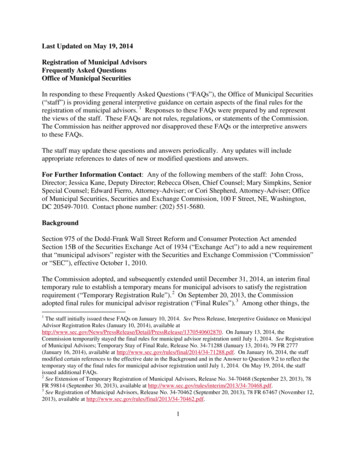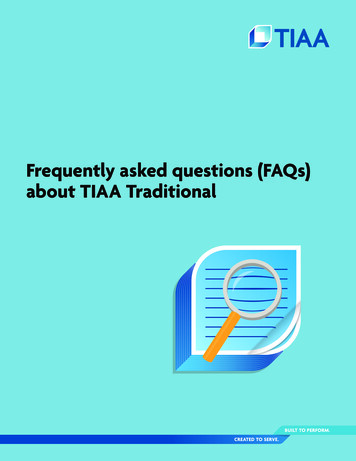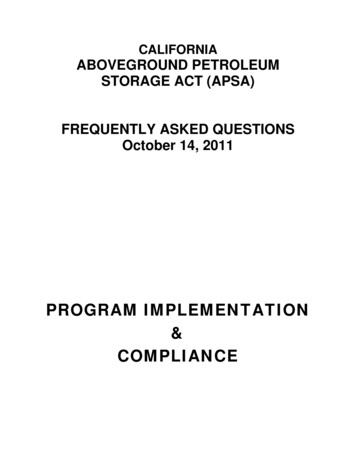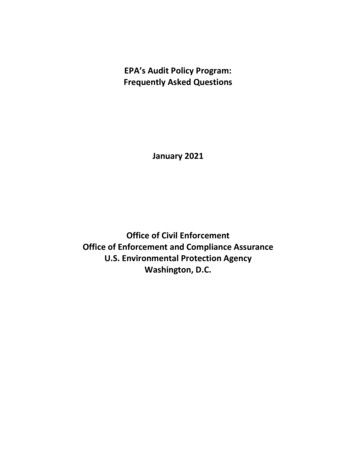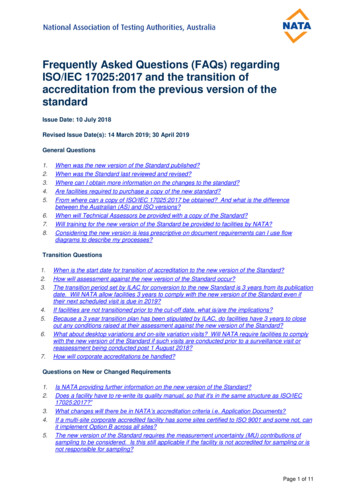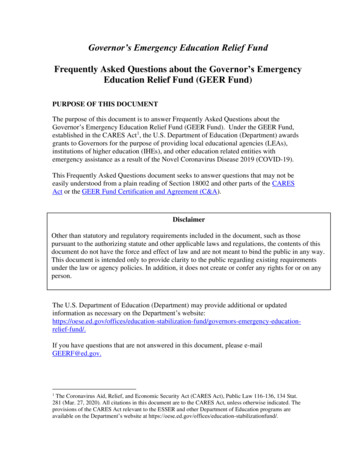
Transcription
Governor’s Emergency Education Relief FundFrequently Asked Questions about the Governor’s EmergencyEducation Relief Fund (GEER Fund)PURPOSE OF THIS DOCUMENTThe purpose of this document is to answer Frequently Asked Questions about theGovernor’s Emergency Education Relief Fund (GEER Fund). Under the GEER Fund,established in the CARES Act1, the U.S. Department of Education (Department) awardsgrants to Governors for the purpose of providing local educational agencies (LEAs),institutions of higher education (IHEs), and other education related entities withemergency assistance as a result of the Novel Coronavirus Disease 2019 (COVID-19).This Frequently Asked Questions document seeks to answer questions that may not beeasily understood from a plain reading of Section 18002 and other parts of the CARESAct or the GEER Fund Certification and Agreement (C&A).DisclaimerOther than statutory and regulatory requirements included in the document, such as thosepursuant to the authorizing statute and other applicable laws and regulations, the contents of thisdocument do not have the force and effect of law and are not meant to bind the public in any way.This document is intended only to provide clarity to the public regarding existing requirementsunder the law or agency policies. In addition, it does not create or confer any rights for or on anyperson.The U.S. Department of Education (Department) may provide additional or updatedinformation as necessary on the Department’s -fund/.If you have questions that are not answered in this document, please e-mailGEERF@ed.gov.1The Coronavirus Aid, Relief, and Economic Security Act (CARES Act), Public Law 116-136, 134 Stat.281 (Mar. 27, 2020). All citations in this document are to the CARES Act, unless otherwise indicated. Theprovisions of the CARES Act relevant to the ESSER and other Department of Education programs areavailable on the Department’s website at nfund/.
A. Basic Information about the Governor’s Emergency Education Relief FundA-1. How does a Governor apply for a State’s share of the GEER Fund?To apply for a State’s allocation from the GEER Fund, a Governor must submit to theDepartment an executed Certification and Agreement that the Secretary sent to theGovernor on April 14, 2020. The Certification and Agreement includes specificprogrammatic, fiscal and accountability assurances, including those related to“maintenance of effort” (MOE), equitable services for students and teachers in nonpublicschools, and continued payments to employees and contractors. A Governor must alsoprovide information on the extent that the funds will be used for remote learning.The term “Certification and Agreement” in these FAQs refers to the Governor’sapplication for GEER funds as required in section 18002(a). The Certification andAgreement is available at -2. How long after submitting a Certification and Agreement should a Governoranticipate receiving funds?The Department expects to award funds within three business days of receiving aGovernor’s completed Certification and Agreement.A-3. Which entities can receive emergency grants from Governors through theGEER Fund?Governors may provide subgrants to local educational agencies (LEAs) and institutionsof higher education (IHEs) within their jurisdiction that have been “most significantlyimpacted by coronavirus” to support their ability to continue providing educationalservices to their students and to support the “on-going functionality” of these entities. Inaddition, a Governor may use these funds to provide support through a subgrant or acontract to other LEAs, IHEs, and education-related entities that the Governor “deemsessential” for carrying out emergency educational services, providing child care and earlychildhood education, providing social and emotional support, and protecting educationrelated jobs. In these FAQs, LEAs, IHEs and education-related entities are collectivelycalled “eligible entities.”For purposes of the GEER Fund, the term “local educational agency” is defined inSection 8101(30) of the ESEA. In lay terms, a LEA is a local school district, althoughpublic charter schools can also be LEAs. The term “institution of higher education” isdefined in Sections 101 and 102 of the Higher Education Act of 1965, as amended(HEA). In lay terms, an IHE is a postsecondary institution that is accredited, legallyauthorized by the State, and recognized by the Secretary of the U.S. Department ofEducation.
A-4. What is an “education-related entity”?The GEER Fund statute allows subgrants to, or contracts with, education-related entities.An education-related entity is a governmental, nonprofit or for-profit entity within theState that provides services that support preschool, elementary, secondary, or highereducation. Such entities may include, for example: State agencies that oversee or directly provide early childhood educationservices; Public agencies or private entities that coordinate or directly provide earlyintervention services under Part C of the Individuals with DisabilitiesEducation Act (IDEA); State agencies that oversee or provide vocational rehabilitative services; State mental health agencies; State Higher Education Boards; Education-related non-profit organizations; Non-public elementary, secondary and postsecondary schools; For-profit elementary, secondary and postsecondary schools; Charter management organizations; Non-profit and for-profit child-care centers; Public libraries; Community centers; and State or local agencies coordinating food services for students and theirfamilies.A-5. Is a Governor required to award the funds to each category of eligible entities(i.e., LEAs, IHEs, and educational related entities)?No. A Governor has wide discretion in determining the entities in the State that willreceive GEER funds. A Governor can choose to fund only LEAs, only IHEs, onlyeducation-related entities, or any combination of eligible entities.A-6. In order to provide emergency grants to IHEs and LEAs (which receive directaid through other parts of the CARES Act), does the Governor need to make anyother determinations?If the recipients are LEAs, the State educational agency (SEA) must determine that theLEAs have been the “most significantly impacted by coronavirus” to be eligible for aGEER Fund emergency grant. Similarly, if IHEs are the recipients, the Governor mustdetermine them to be the “most significantly impacted by coronavirus.”The Department will require Governors to make publicly available the criteria used indetermining the LEAs and IHEs that are “most significantly impacted by coronavirus,”including how they formulated the criteria.2
A-7. May the Governor use GEER funds to award scholarships, microgrants orfinancial aid directly to students or teachers?No, not directly. If Governors wish to provide scholarships, financial assistance ormicrogrants to students or teachers, they must provide a subgrant to an eligible entity,which could, in turn, provide scholarships or microgrants consistent with the CARESAct. A Governor is prohibited from awarding GEER funds to individuals.A-8. May a Governor or an eligible entity use GEER funds to pay for costs incurredprior to receiving grant funds?Yes. A Governor or an eligible entity may use GEER funds for any allowableexpenditure incurred on or after March 13, 2020, the date the President declared thenational emergency due to COVID-19.A-9. May a Governor or a subgrant eligible entity use GEER funds to defray thecosts of administering the program?Yes. The Governor and each eligible entity may charge as an expense to the GEER Fundan amount that is reasonable and necessary to effectively administer the programconsistent with cost principles in 2 C.F.R. part 200, subpart E of the UniformAdministrative Requirements, Cost Principles, and Audit Requirements for FederalAwards (Uniform Guidance). Administrative costs include costs (direct and indirect)involved in the proper and efficient performance and administration of this Federal grant.However, to maximize the funds available for services to students and the public, theDepartment encourages each Governor and subgrantee to minimize the amount ofadministrative costs charged to the program.A-10. May a Governor set a specific administrative cost cap on eligible entities tomaximize the amount of funding available for services?Yes. To maximize the funds available for services to students and the public, theDepartment encourages each Governor to limit the amount that subrecipients can chargefor direct administrative costs in carrying out their GEER Fund projects.A-11. Who should a Governor designate to be the fiscal agent for the GEER Fundgrant?Each Governor must designate a State Agency as the fiscal agent to administer the GEERFund, which may be the Office of the Governor or another State entity. In the GEERFund Certification and Agreement, the Governor provides the legal name of the StateAgency serving as the fiscal agent and its DUNS number.The fiscal agent is responsible for overseeing and monitoring all GEER Fund activities inthe State. Therefore, it is recommended that the Governor designate an agency with3
appropriate experience in administering Federal grants and an understanding of the typesof activities that may be supported by the GEER Fund.The fiscal agent may partner with additional State Agencies or other entities to administerthe State’s GEER Fund. However, such arrangements do not obviate the fiscal agent’sresponsibility for oversight of the GEER Fund.A-12. Is there a deadline by which a Governor must award GEER funds to eligibleentities (i.e., LEAs, IHEs, and education related entities)?Yes. Each Governor must award the State’s allocation under the GEER Fund to eligibleentities within one year of receiving the State’s allocation. Any funds that the Governorfails to award by the one-year deadline must be returned to the Department forreallocation to the remaining States.A-13. How does a Governor award emergency funds to eligible entities?Emergency support to LEAs and IHEs under sections 18002(c)(1) and (c)(2) of theCARES Act must be awarded through subgrants. Support provided to LEAs, IHEs, oreducation-related entities under 18002(c)(3) may be provided through either subgrants orcontracts. When the Governor awards funds to LEAs, IHEs, or education-related entitiesthrough subgrants, the designated State Agency fiscal agent carries out the requirementsfor a pass-through entity described in 2 C.F.R. § 200.331. When the Governor awards acontract to an eligible entity, the Governor must follow the State’s procurement processas required by 2 C.F.R. § 200.317.A-14. Must an LEA submit a local application to the Governor in order to receivean award under the GEER Fund?Yes. An LEA must file a local application with the Governor in order to receive a GEERFund subgrant.2 Each Governor will develop their own application process andapplication criteria; LEAs should contact the relevant State office for additional details.For information about what a Governor must include in its local application for a GEERsubgrant, please reference the GEER Certification & Agreement.A-15. How much flexibility does an LEA have in determining the activities tosupport with GEER funds?Unless otherwise restricted by the Governor at the time he or she awards GEER Fundsubgrants or contracts, the LEA (including a public charter school LEA) has considerableflexibility in determining how best to use GEER funds to prevent, prepare for, or respondto COVID-19. The LEA may use these funds for, among other things, any activities thatare authorized under the ESEA.2For further information, please see 34 C.F.R. § 76.301.4
A-16. How may an LEA or an IHE use GEER funds to support continuededucation for all students through distance education?The Department encourages States, LEAs and IHEs to invest GEER funds in technologyinfrastructure and professional development that will improve capacity to provide highquality, accessible, distance education, or remote learning. This may include – Providing off-campus access to reliable, high-speed internet for students andteachers through the purchase of internet-connected devices/equipment, mobilehotspots, wireless service plans, or installation of Community Wi-Fi Hotspots,especially in underserved communities; Purchasing hardware and software applications for students and teachers; Providing access to high-quality digital learning content, apps, and tools that candeliver engaging and relevant learning experiences that are accessible to allstudents; Covering costs associated with making materials accessible for students withdisabilities or English learners; and Providing professional development and training for teachers on effectivestrategies for the delivery of remote and digital instruction.A-17. How may an IHE use GEER funds?Subject to any restrictions that a Governor places on an IHE’s use of GEER funds, anIHE may use the funds, awarded under section 18002(c)(2) of the CARES act, to supporta broad array of activities. For example, an IHE might use GEER funds to provide: Staff, infrastructure and technology to support distance education, or remotelearning;Academic support for libraries, laboratories, and other academic facilities;Institutional support for activities related to personnel, payroll, security,environmental health and safety, and administrative offices;Student services that promote a student’s emotional and physical well-beingoutside the context of the formal instructional program; andStudent financial aid, such as IHE-sponsored grants and scholarships.A-18. How long are GEER funds available for obligation by subrecipients?An LEA, IHE, or education-related entity receiving a subgrant from the Governor mustobligate the funds by September 30, 2022 which includes the Tydings period (GeneralEducation Provisions Act §421(b)(1)). However, the GEER Fund is an emergencyappropriation to address the harm to students and the ongoing functionality of LEAs andIHEs caused by COVID-19. As a result, the Secretary strongly urges LEAs, IHEs andeducation-related entities to deploy GEER funds quickly.5
A-19. Does subgranting of funds to an eligible entity constitute a final “obligation”of those funds?No. Subgranting funds to an LEA, IHE, or education-related entity does not constitute afinal or ultimate obligation of those funds. Rather, those funds are considered a finalobligation when the LEA or IHE commits those funds to specific purposes.3For example, if an LEA awards a contract, that is an obligation. In contrast, subgrantingfunds to an LEA or other subrecipient is not an obligation; rather, these funds are notobligated until the LEA or other subrecipient commits the funds to specific purposes.A-20. What maintenance of effort (MOE) requirements apply to the GEER Fund?The Department intends to issue an FAQ soon about meeting the MOE requirements inthe CARES Act and applying for an MOE waiver.3See 34 C.F.R. § 76.707 for the specific requirements for when an obligation is made.6
/Governor's Education Emergency Relief FundStateAllocationTotal aColoradoConnecticutDelawareDistrict of kaNevadaNew HampshireNew JerseyNew MexicoNew YorkNorth CarolinaNorth ,35432,507,956104,418,2407
Governor's Education Emergency Relief FundStateAllocationTotal 2,953,230,000Rhode IslandSouth CarolinaSouth est VirginiaWisconsinWyomingPuerto 1446,550,4114,700,93747,812,2368
for a pass-through entity described in 2 C.F.R. § 200.331. When the Governor awards a contract to an eligible entity, the Governor must follow the State's procurement process as required by 2 C.F.R. § 200.317. A-14. Must an LEA submit a local application to the Governor in order to receive an award under the GEER Fund? Yes.


